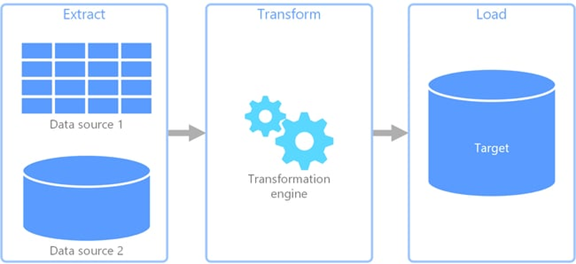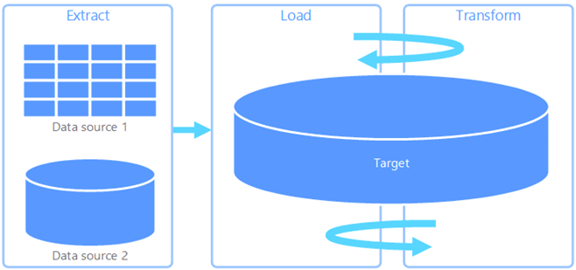

Extract, Transform, and Load (ETL) and Extract, Load, and Transform (ELT) are the two most popular techniques for getting data from single or several sources into a centralized system for simple access and analysis.
Both ETL and ELT use extract, transform, and load phases to compile data. The difference lies in the sequence of events. Though you might assume that a small modification to the order of the phases wouldn’t matter, in fact it drastically alters how the integration process flows.
In short, ETL processes data from multiple sources and then loads it into a single database, while ELT waits until after it has been loaded to process it, allowing it to be transformed multiple times as needed.
ETL is a method of data integration that enables businesses to gather data from many sources and transfer it all to a single destination database. Three phases make up the ETL process: extraction, transformation, and loading.

ELT is a method of data integration that transmits data from a source system to a destination system without subjecting the data to business logic-driven changes. Three steps make up the ELT procedure: extraction, loading, and transformation.

In both ETL and ELT techniques, businesses may combine data from several databases into a single data repository where it can be prepared and qualified appropriately.
For analysis and further processing, this integrated data repository offers streamlined access.
Furthermore, it provides a single source of truth, guaranteeing that all enterprise data is accurate and current.
Despite what appears to be a minor change in process, there are far more differences between ETL and ELT than similarities. The following table breaks down the differences:
| Parameters | ETL | ELT |
| Process | The staging server transforms data, which is subsequently transmitted to the data warehouse (DWH) | Data continues to exist untransformed in the DWH |
| Code Usage | Applied to small amounts of data or computationally demanding transformations | Applied to large data sets |
| Load Time | A lengthy process where data is first loaded into the staging server and then loaded to the target system | A faster process where data is loaded once into the target system |
| Transformation Sequence | Transformations are carried out in the staging area of the ETL server | Transformations are carried out in the target system |
| Transformation Time | Load process will have to wait until the transformation is completed. This increases data size and transformation time | Speed will never depend on the size of the data in the ELT process |
| Maintenance Time | High maintenance time is required to load and transform the data | Data is always available in ELT, so low maintenance time is required |
| Implementation Complexity | Easier to implement at an early stage | Deep knowledge of tools and expertise are required to implement the ELT |
| Support for DWH | Used for structured and relational data and on-premises infrastructures | Used for structured and unstructured data in a scalable cloud architecture |
| Data Lake Support | Not supported | Utilizes unstructured data in the Data Lake |
| Complexity | Loads the crucial data that was determined at design time | Development is done using the output backwards, and only related data is loaded |
| Cost | Expensive for small and medium-sized enterprises | Online SaaS platforms keep costs low |
| Lookups | The staging area must have both facts and dimensions available | Because extract and load happen in a single event, all data will be available |
| Aggregations | Complexity increases with additional data added to the dataset | The target platform can process a considerable volume of data quickly |
| Hardware | Could be expensive with the unique hardware requirements of the tools | The cost of SaaS hardware is not a concern |
| Support for Unstructured Data | Relational data is mostly supported | Supports unstructured data |
Both ETL and ELT have some advantages and disadvantages depending on your corporate network’s size and needs. In general, ETL is a stalwart process with strong compliance protocols that suffers in speed and flexibility, while ELT is a relative newcomer that excels at rapidly migrating a large data set but lacks the dependability and security of its predecessor.
The advantages of ETL include faster analysis, environmental flexibility, dependable compliance, and model maturity.
Disadvantages of ETL include slow loading speeds, an inflexible workflow, and bogging down at high data volumes.
The advantages of ELT include flexibility of data formats and transformation timing, as well as the speed of loading and implementing data.
Despite its many advantages, ELT is a newer approach than ETL and may run up against some compliance and compatibility issues.
ETL and ELT each have particular uses for the data integration you may be trying to accomplish. Various aspects, like the data you have, the kind of storage you use, and the long-term requirements of your organization, might influence your decision regarding the best option for you.
Data quality and integrity will both be increased by the ETL and ELT techniques. Data structure for deeper analysis and investigation is the biggest strength of ETL, whereas speed and support for a variety of data types are the major strengths of ELT.
The goal is to weigh the benefits and disadvantages of both systems against your own needs to determine which one best suits the data management requirements and procedures of your organization. Either will remove annoying data silos and provide visibility throughout the organization.


Nisar is a contributing writer for ServerWatch as well as a founder of Techwrix.com, a Sr. Systems Engineer, double VCP6 (DCV & NV), and a seven-time vExpert (2017-23), with 12 years of experience in administering and managing data center environments using VMware and Microsoft technologies. He frequently writes on virtualization, cloud computing, hyper-convergence (HCI), B2B technology, cybersecurity, and backup and recovery solutions. His work has also been featured in Cloud Academy, Altaro, and Geekflare.
Property of TechnologyAdvice. © 2025 TechnologyAdvice. All Rights Reserved
Advertiser Disclosure: Some of the products that appear on this site are from companies from which TechnologyAdvice receives compensation. This compensation may impact how and where products appear on this site including, for example, the order in which they appear. TechnologyAdvice does not include all companies or all types of products available in the marketplace.